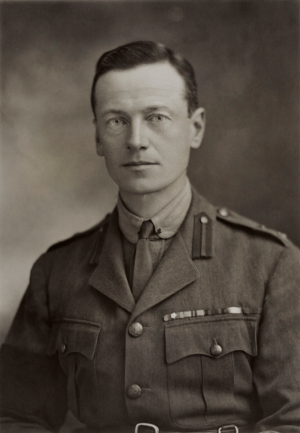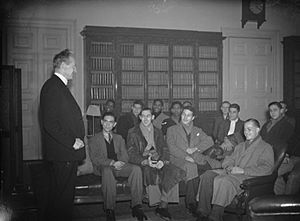Walter Guinness, 1st Baron Moyne facts for kids
Quick facts for kids
The Lord Moyne
DSO PC
|
|
|---|---|

First World War portrait, 1918
|
|
| Leader of the House of Lords Secretary of State for the Colonies |
|
| In office 8 February 1941 – 22 February 1942 |
|
| Monarch | George VI |
| Prime Minister | Sir Winston Churchill |
| Preceded by | The Lord Lloyd |
| Succeeded by | Viscount Cranborne |
| Parliamentary Secretary to the Ministry of Agriculture and Fisheries | |
| In office 10 May 1940 – 8 February 1941 Serving with Tom Williams
|
|
| Monarch | George VI |
| Prime Minister | Sir Winston Churchill |
| Preceded by | The Lord Denham |
| Succeeded by | The Duke of Norfolk |
| Minister of Agriculture and Fisheries | |
| In office 4 November 1925 – 4 June 1929 |
|
| Monarch | George V |
| Prime Minister | Stanley Baldwin |
| Preceded by | E. F. L. Wood |
| Succeeded by | Noel Buxton |
| Financial Secretary to the Treasury | |
| In office 5 October 1923 – 23 January 1924 |
|
| Monarch | George V |
| Prime Minister | Stanley Baldwin |
| Preceded by | Sir William Joynson-Hicks |
| Succeeded by | William Graham |
| Parliamentary Under-Secretary of State for War | |
| In office 31 October 1922 – 5 October 1923 |
|
| Monarch | George V |
| Prime Minister | Bonar Law Stanley Baldwin |
| Preceded by | Robert Sanders |
| Succeeded by | Wilfrid Ashley |
| Member of the House of Lords Lord Temporal |
|
| In office 21 January 1932 – 6 November 1944 Hereditary peerage |
|
| Preceded by | Peerage created |
| Succeeded by | The 2nd Baron Moyne |
| Member of Parliament for Bury St Edmunds |
|
| In office 24 August 1907 – 27 October 1931 |
|
| Preceded by | Frederick Hervey |
| Succeeded by | Frank Heilgers |
| Personal details | |
| Born |
Walter Edward Guinness
29 March 1880 Dublin, Ireland |
| Died | 6 November 1944 (aged 64) Cairo, Egypt |
| Nationality | British |
| Political party | Conservative |
| Spouse | Lady Evelyn Erskine |
| Children | 3, including Bryan Guinness, 2nd Baron Moyne |
| Parents | Edward Guinness, 1st Earl of Iveagh Adelaide Guinness |
| Military service | |
| Allegiance | |
| Branch/service | |
| Years of service | 1899–1918 |
| Rank | Brigade major |
| Battles/wars | |
Walter Edward Guinness, 1st Baron Moyne (born March 29, 1880 – died November 6, 1944) was an important British politician and businessman. He was known for his work in the Middle East as a British minister. Sadly, he was killed in November 1944 by a Jewish extremist group called Lehi. His death caused a lot of shock around the world.
Contents
Early Life and Family Background
Walter Guinness was born in Dublin, Ireland. He was the third son of the 1st Earl of Iveagh, whose family was famous for the Guinness brewing company. His family lived in large homes in Dublin and Suffolk, England.
In 1903, Walter Guinness married Lady Evelyn Hilda Stuart Erskine. They had three children together:
- Bryan Walter Guinness, 2nd Baron Moyne (1905–1992)
- Hon. Murtogh David Guinness (1913–2002)
- Hon. Grania Meve Rosaura Guinness (1920–2018)
Military Service and Achievements
Walter Guinness had a distinguished military career.
- He joined the Suffolk Yeomanry in 1899.
- He fought in the Second Boer War in South Africa.
- For his bravery in the Boer War, he was honored with the Queen's South Africa Medal.
During World War I, he served with the Suffolk Yeomanry in Egypt and at Gallipoli.
- He became a brigade major in 1916.
- He earned the DSO in 1917 for his courage near Passchendaele.
- He received another honor (a bar to his DSO) in 1918 during the German spring offensive.
- He finished the war as a lieutenant-colonel.
Starting a Political Career
Guinness began his political journey as a Conservative candidate.
- He was elected to the London County Council in 1907 and served until 1910.
- In 1907, he also became a Member of Parliament (MP) for Bury St Edmunds. He held this position until 1931.
- He supported conservative ideas like opposing Home Rule for Ireland.
After World War I, Guinness became Under-Secretary of State for War in 1922. He lost this job when the Labour government came to power in 1924. However, he was soon made a member of the Privy Council.
Working with Winston Churchill
Walter Guinness started working closely with Winston Churchill in 1924.
- He became the Financial Secretary to the Treasury under Churchill, who was the Chancellor.
- Together, they worked to put the Pound sterling back on the gold standard.
- From 1925 to 1929, he served as Minister of Agriculture. He helped increase the amount of sugar beet grown in Britain.
In 1931, he did not seek re-election as an MP. Instead, he was given the title of Baron Moyne in 1932, which meant he became a member of the House of Lords.
Business and Charity Work
Lord Moyne was also involved in business and helping others.
- He was a director of the famous Guinness brewing company.
- He started British Pacific Properties in Canada and helped build the Lions Gate Bridge, which was the longest bridge in the British Empire at the time.
- He was a trustee for the Guinness Trust and the Iveagh Trust, which provided affordable housing.
- In 1927, he helped arrange the donation of Kenwood House and its art collection to the nation.
His Yachts and Travels
Lord Moyne owned several yachts, which he used for travel and exploration.
- In 1926, he bought a ferry and turned it into a steam yacht called Arpha.
- In 1931, he bought another ferry, converted it to diesel, and named it Roussalka. This ship was unfortunately wrecked in 1933.
- In 1933, he bought a third ferry, Dieppe, and renamed it Rosaura.
- He used the Rosaura for trips, including a voyage with Winston Churchill and his wife.
- He traveled to the Pacific and brought the first living Komodo dragon to Britain.
- He wrote two books about his travels and the cultures he met: Walkabout (1936) and Atlantic Circle (1938).
His travels and shared concerns about government policies and the rise of Hitler strengthened his friendship with Winston Churchill. They were both worried about Germany's rearmament before World War II.
Later Political Roles
Even after joining the House of Lords, Lord Moyne remained active in politics.
- In 1932, he helped oversee Kenya's finances.
- In 1933, he led a committee focused on clearing slums in England.
- In 1938, he chaired the West Indies Royal Commission, which looked into how British colonies in the Caribbean should be governed.
When World War II began in 1939, Moyne became involved in the war effort.
- He chaired the Polish Relief Fund in London.
- When Winston Churchill became prime minister in May 1940, Moyne held several important positions in the government.
- He became Secretary of State for the Colonies in February 1941.
- He also led the government's business in the House of Lords as Leader of the House of Lords.
- From 1942 until his death, he was the Minister-Resident for the Middle East in Cairo. This role gave him control over British affairs in the Middle East and Africa. His main goal was to help defeat the Axis forces in North Africa.
Lord Moyne and Palestine
Lord Moyne's role in the Middle East meant he was involved in policies concerning Mandatory Palestine, a territory under British control.
His Views on Palestine
- Moyne believed in a federation (a union of states) of Palestine, Transjordan, and Syria.
- He supported the idea of a Jewish state within this federation.
- Some people claimed he was against Jewish settlement in Palestine, but historians say this is not true. He believed that different groups mixing together could lead to progress.
"Blood for Trucks" Proposal
In 1944, a man named Joel Brand approached the British with a shocking offer from the Nazis. The Nazis offered to release up to one million Hungarian Jews in exchange for 10,000 trucks and other goods. This was known as the "blood for trucks" proposal.
- Brand was questioned in Cairo. He later claimed that Lord Moyne had said, "What can I do with a million Jews? Where can I put them?"
- However, historians like Bernard Wasserstein believe that Brand likely never met Moyne. This comment was probably made by another British official.
- The British government did not accept the Nazi offer, partly because they thought it might be a trick.
Assassination of Lord Moyne
On November 6, 1944, two members of the Jewish extremist group Lehi, Eliyahu Bet-Zuri and Eliyahu Hakim, waited for Lord Moyne near his home in Cairo.
- When Moyne arrived in his car, Bet-Zuri shot his driver, Lance Corporal Arthur Fuller.
- Hakim then shot Lord Moyne.
- The two attackers tried to escape on bicycles but were caught by an Egyptian policeman.
- Lord Moyne was rushed to the hospital but died later that evening at age 64. His driver also died.
Moyne's body was returned to England and cremated.
Reasons for the Assassination
The Lehi group targeted Lord Moyne for several reasons:
- He was the highest-ranking British official they could reach in the Middle East.
- They believed he was responsible for Britain's strict immigration policies in Palestine, which limited Jewish refugees.
- They wanted to show the world that the conflict was not just between a government and its citizens, but between the Jewish people and British rule.
- They aimed to bring their "War of Liberation" to international attention.
Trial and Aftermath
- Bet-Zuri and Hakim were tried in an Egyptian court.
- They were found guilty and sentenced to death on January 18, 1945.
- Their appeals were denied, and they were executed on March 23, 1945.
Lord Moyne's death had a big impact.
- Jewish leaders in Palestine quickly condemned the assassination.
- Chaim Weizmann, who later became the first President of Israel, expressed deep sadness.
- British Prime Minister Winston Churchill was very upset. He warned that such actions could make him reconsider his support for Zionism.
- The assassination caused British plans to divide Palestine after the war to be put aside.
In 1975, Egypt returned the bodies of Bet-Zuri and Hakim to Israel. They were given a state funeral and buried with military honors. This caused a formal protest from Britain.
Collections and Legacy
Lord Moyne had a large collection of ancient and cultural artifacts. These were later acquired by the British Museum in London and the Museum of Archeology and Anthropology in Cambridge.
Images for kids
See also
 In Spanish: Walter Guinness para niños
In Spanish: Walter Guinness para niños




